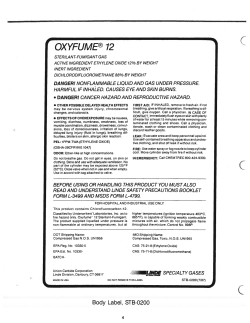
installation guide Air Arm 4xx-5xx - HuMa
Regulator installation guide for Air Arms 4xx/5xx Before you you start, realize this; You are working on a high pressure rifle; this could potentially be harmful to you or bystanders if you do not know what you are doing. Do not attempt to install this regulator yourself if you do not have a clear understanding of how these pcp rifles and regulators work. Installation and operation is done completely at your own risk. Installing this regulator might void your rifle’s factory warranty. We cannot be held liable for any accidents in relation to this regulator and its installation. Before you start, make absolutely sure that ALL the air is drained from the pressure tube. If there is a pressure gauge, it will give you just an indication. Dry fire the rifle to make sure all the air is out of the rifle. Loosen the two set screws on both sides of the barrel bracket and slide the bracket off the end of the barrel. Remove the two screws from the end of the Striker Body. (Note this is a S500 FAC assembly and does not have anti-tamper devices plugging the screw holes. If your model is not FAC, the plugs will need to be removed.) Remove the four screws from the Valve Body in front of the trigger. These screws will be easier to remove if the trigger guard is removed first. The Breech and Barrel assembly can now be lifted from the rest of the rifle body. Be careful not to lose the white plastic seal washer, it can fall off easily. Dis-assembled parts. Remove the Power Adjustment knob by loosening the set screw in the valve body directly under the knob. Taking this knob out is not required, but it will make removing the cylinder easier. There is a small spring and a dowel pin under the set screw. Place them aside so they are not lost. Remove the Cylinder Pressure Gauge. This is a very tightly torqued screw, so be careful not to strip the hex. It will come out and there is no thread locking compound used here, it is just very tight. Again, removal of the pressure gauge is not required, but it will make removing the cylinder easier. Before removing the cylinder, make a small mark across both the cylinder end and the valve body. This will give a reference point to tighten the cylinder to at re-assembly. Again, a very tightly torqued connection. To remove the cylinder it is necessary to hold the cylinder very tightly. Here, two automotive hose clamps are used with a thick rubber strip underneath. Tighten them as much as possible. This helps grip the cylinder, and prevents scratches. We don’t want any damage to this rifle Install the stock bolt into its mounting hole and place a box end wrench over the bolt to provide good leverage for loosening the cylinder. Protect the whole assembly with a rag as it is clamped in a bench vise. This is what you see as the cylinder is removed. Mark the POT with the length of the spacer provided with the regulator. This is the maximum length the POT could be and still allow proper installation of the regulator. The POT actually will be cut a bit shorter than this length. Remove the POT by loosening the set screw in the side of the Valve Body, just where the POT is attached. To get the correct placement of the breather hole for the regulator in the cylinder, place the spacer and regulator at the end of the valve body. Measure the distance from the face of the valve body to the breather hole in the regulator. Place a piece of masking tape on the centerline of the cylinder along the bottom of the cylinder. Draw a straight line on the tape along the centerline, and transfer the dimension of the breather hole to the cylinder. Carefully center punch and drill the breather hole using a 1mm or 1/16 inch drill bit. This is best done in a drill press with the cylinder firmly clamped in place, but if you are careful not to let the bit wander, it can be done with a hand drill. Clean the burrs off the inside and outside of the hole. It should look like this when finished. It is extremely important that the inside burrs are completely removed and the inside surface is smooth. Any remaining burr will ruin the O-ring seal on the regulator and the air will leak out the breather hole. Finish sand the inside of the cylinder with 600 grit silicon wet sand paper or finer, until the surface is clean and shines. Clean any remaining grit or debris from the inside of the cylinder. Using a coarse thread wood screw in a hex driver (held in place with a small piece of paper here), insert this into the center hole of the white plastic piece inside the cylinder and thread it in a few turns. Using a piece of wire with a loop formed at the end (sorry, no picture) grab the head of the screw and pull the plastic insert to the end of the cylinder. Once the head of the screw is close to the end of the cylinder, finish removing the plastic piece with needle nose pliers. I don’t even know what this piece is! It is not called out in the Air Arms parts list, and for our purposes, is not required. It won’t matter if this is left in place, however. Mark the POT at a spot that creates a final length about 3mm (3/16 inch) shorter than the regulator spacer. The POT also keeps the valve spring in place and has a shoulder inside to do so. DO NOT cut the POT shorter than the shoulder location. The POT can be cut using many ways, a lathe being the best. But if a lathe is not available, the POT can be effectively cut by chucking it in a drill press and using a hack saw blade to cut off the remaining portion (sorry, forgot to take a picture of that set-up). Below is the cut POT re-installed into the Valve Body. This is what the spacer should look like when placed around the shortened POT. Notice the internal shoulder inside the POT that retains the valve spring. Also notice the chamfered inside edge of the POT. Coat the inside of the cylinder and the outer surface of the regulator with silicone grease. Align the breather hole with the witness mark on the cylinder centerline so the hole will align with the breather hole in the cylinder. Gently press the regulator into the cylinder with your thumb until it passes the inside threads of the cylinder. Then position the spacer in front of the regulator and press the two together further into the cylinder until the threads are exposed enough to thread the valve body into place. Regulator and spacer in place, with the breather hole aligned to the hole in the cylinder, ready to thread the valve body into place. Regulator installed and valve body fully threaded into place. Use the hose clamps, rubber strips, and protective rag in the bench vise to get a good grip on the cylinder for tightening. Be sure to align the witness marks made earlier during final tightening of the valve body. This ensures the proper torque on the connection. Note; the breather hole does not necessarily need to line up with the hole in the cylinder. There is enough space between the regulator and the inside diameter of the tube to allow proper venting. Tightening the valve body until the witness marks align ensures proper torque on the connection
© Copyright 2025









